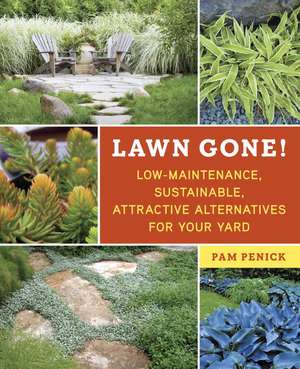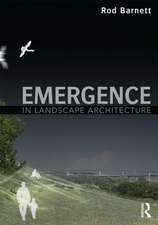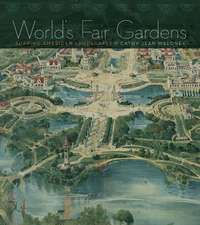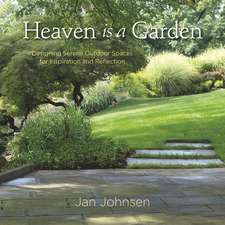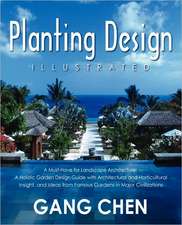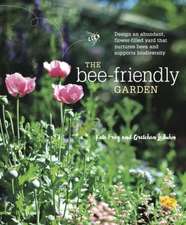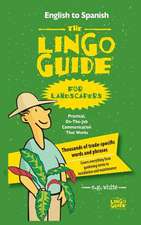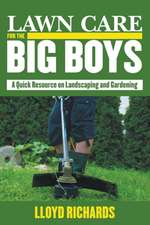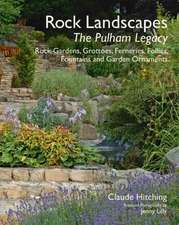Lawn Gone!: Low-Maintenance, Sustainable, Attractive Alternatives for Your Yard
Autor Pamela Sue Penicken Limba Engleză Paperback – 11 feb 2013
Homeowners spend billions of hours—and dollars—watering, mowing, and maintaining their lawns. You don’t have to be one of them. Free yourself with Lawn Gone!, a colorful, accessible guide to the basics of replacing a traditional lawn with a wide variety of easy-care, no-mow, low-water, money-saving options. It includes:
• alternative grasses that seldom (or never) need mowing
• drought-tolerant, eco-friendly landscapes
• regional plant recommendations for all parts of the country
• artificial turf that looks like the real thing
• step-by-step lawn-removal methods
• strategies for dealing with neighbors and HOAs
• ways to minimize your lawn if you’re not ready to go all the way
Whether you’re a beginner or expert gardener, green thumb or black, Lawn Gone! provides realistic choices, achievable plans, and simple instructions for renovating your yard from start to finish.
Preț: 119.96 lei
Nou
Puncte Express: 180
Preț estimativ în valută:
22.96€ • 23.88$ • 18.95£
22.96€ • 23.88$ • 18.95£
Carte disponibilă
Livrare economică 25 martie-08 aprilie
Preluare comenzi: 021 569.72.76
Specificații
ISBN-13: 9781607743149
ISBN-10: 1607743140
Pagini: 184
Ilustrații: 125 Full-Colour Illustrations
Dimensiuni: 187 x 229 x 15 mm
Greutate: 0.55 kg
Editura: Ten Speed Press
ISBN-10: 1607743140
Pagini: 184
Ilustrații: 125 Full-Colour Illustrations
Dimensiuni: 187 x 229 x 15 mm
Greutate: 0.55 kg
Editura: Ten Speed Press
Notă biografică
PAM PENICK is a landscape designer, garden writer, photographer, and award-winning blogger who has replaced many lawns in her lifetime, including her own. She is a contributor to Garden Design, Fine Gardening, and Martha Stewart’s blog At Home in the Garden. Penick lives in Austin, Texas, and blogs at www.penick.net/digging.
Extras
Introduction
A green, neatly cut lawn has long been part of the American dream of homeownership.
Since the development of our earliest suburbs, lawn has occupied a privileged place as the default groundcover for builders and homeowners alike. In the late 1800s, Frederick Law Olmsted, the founding father of American landscape architecture, sought to elevate our nation’s homesteader aesthetic of bare dirt, vegetable patch, and fenced yard for keeping out livestock. He looked to the greenswards of grand English estates and envisioned an uninterrupted carpet of lawn spread across new suburban developments, unbroken by fence, hedge, or wall (unlike the aristocratic English model)—a commons shared by each homeowner, whose civic responsibility included maintaining his own piece of it. Lawn, proclaimed Olmsted, would be an expression of democracy. Drive the neighborhood streets of almost any town in the United States today and you’ll see Olmsted’s vision brought to life, with one lawn flowing into the next all the way down the block.
It’s easy to see how the lawn became so popular. When maintained with water and regular grooming, it covers the ground superbly and can be used for play and relaxation. Installing a lawn is fairly inexpensive, and the tidy openness of a lawn is comfortably familiar. Lawn culture—weekly mowing and edging, running the sprinkler in summer, and applying chemical fertilizer, pesticides, and weed suppressants—became firmly entrenched in the 1950s, when home ownership surged, and today many homeowners’ associations (HOAs) and city councils have codified standards for a front lawn that each resident must maintain. Just look at the lawn-care aisles—packed with chemicals, hoses, and equipment—at your local home-improvement store to see what a big business lawn maintenance has become.
The Grass is Not Always Greener
The fact is, however, that traditional lawn grasses aren’t well suited to large regions of our country—the arid Southwest and Mountain West, in particular, as well as the drought-prone Plains states—and lawns in the South and Midwest often require copious summer watering to be kept green. Lawn fertilizers and pesticides have proved toxic to birds, to beneficial insects, and, when they wash into watersheds, to fish and rivers. Lawns lack cover, food, and nesting material for wildlife. A typical lawn requires several hours of maintenance each week during the growing season, and the power tools used for this time-consuming maintenance come with a high cost in terms of air and noise pollution.
Today, we have a better understanding of the lawn’s impact on the environment. We’re mindful of water shortages, runoff tainted by lawn chemicals, and air and noise pollution caused by maintenance equipment. We’ve come to recognize that the look of a more native landscape is worth cultivating and nurturing. Why should the average homeowner in the arid high country of the Southwest, for example, emulate a lush Southeastern landscape, or vice versa? In other words, why deny the particular beauty of your own region? All around the country you can find the same few species of lawn grasses and foundation shrubs making up a national, undifferentiated residential landscape. It’s like driving cross-country on the interstate and seeing the same four fast-food restaurants at every exit. We deserve better—and we can make it happen.
A Greener Way
Most people hardly use their lawns, especially the front lawn, and it can seem an awful waste to maintain something that you never use. Moreover, other types of plants also do a beautiful job of covering the soil, and many of them require less water and maintenance. Simply by choosing to grow several different species of plants in your yard, you’ll help reduce the “lawn desert,” a monoculture of turf that afflicts so many neighborhoods.
Also, by growing swaths of plants well adapted to your local conditions and including appropriately scaled hardscape—like paths and patios—you’ll ultimately use fewer resources and create a better-looking landscape for your home. You may also spend fewer hours maintaining it. Most rewardingly, you’ll have the satisfaction of knowing that you aren’t harming the environment and you’re maintaining a landscape that invites you to enjoy it. Let’s reclaim our outdoor spaces for relaxation, natural beauty, wildlife habitat, and a sense of living more lightly on the earth.
Lawn Gone! will inspire you with examples of real-life, lawn-free landscapes and show you how to achieve a beautiful yard with practical information about removing the lawn and landscaping without traditional grass (or, at least, with less of it). Whether you’re considering removing all or part of your lawn, Part One will show you different options for covering your soil with low, ground-covering plants, welcoming patios and paths, and enticing features like ponds, firepits, and garden pavilions. When you’re ready to begin, Part Two will walk you through the various methods of lawn removal and explain how to install hardscape and plant your new garden.
If you have HOA rules or city ordinances to contend with, you’ll find Part Three especially helpful. This section also addresses garden pests and ways to minimize their impact and explains how to create a wildfire-resistant landscape. In Regional Plant Recommendations, you’ll find plant picks and local gardening information contributed by regional experts, helping you to pinpoint plants that will thrive in your region.
By picking up this book, you’ve already taken the first step toward a greener way of landscaping. Now let’s explore the possibilities and get inspired!
A green, neatly cut lawn has long been part of the American dream of homeownership.
Since the development of our earliest suburbs, lawn has occupied a privileged place as the default groundcover for builders and homeowners alike. In the late 1800s, Frederick Law Olmsted, the founding father of American landscape architecture, sought to elevate our nation’s homesteader aesthetic of bare dirt, vegetable patch, and fenced yard for keeping out livestock. He looked to the greenswards of grand English estates and envisioned an uninterrupted carpet of lawn spread across new suburban developments, unbroken by fence, hedge, or wall (unlike the aristocratic English model)—a commons shared by each homeowner, whose civic responsibility included maintaining his own piece of it. Lawn, proclaimed Olmsted, would be an expression of democracy. Drive the neighborhood streets of almost any town in the United States today and you’ll see Olmsted’s vision brought to life, with one lawn flowing into the next all the way down the block.
It’s easy to see how the lawn became so popular. When maintained with water and regular grooming, it covers the ground superbly and can be used for play and relaxation. Installing a lawn is fairly inexpensive, and the tidy openness of a lawn is comfortably familiar. Lawn culture—weekly mowing and edging, running the sprinkler in summer, and applying chemical fertilizer, pesticides, and weed suppressants—became firmly entrenched in the 1950s, when home ownership surged, and today many homeowners’ associations (HOAs) and city councils have codified standards for a front lawn that each resident must maintain. Just look at the lawn-care aisles—packed with chemicals, hoses, and equipment—at your local home-improvement store to see what a big business lawn maintenance has become.
The Grass is Not Always Greener
The fact is, however, that traditional lawn grasses aren’t well suited to large regions of our country—the arid Southwest and Mountain West, in particular, as well as the drought-prone Plains states—and lawns in the South and Midwest often require copious summer watering to be kept green. Lawn fertilizers and pesticides have proved toxic to birds, to beneficial insects, and, when they wash into watersheds, to fish and rivers. Lawns lack cover, food, and nesting material for wildlife. A typical lawn requires several hours of maintenance each week during the growing season, and the power tools used for this time-consuming maintenance come with a high cost in terms of air and noise pollution.
Today, we have a better understanding of the lawn’s impact on the environment. We’re mindful of water shortages, runoff tainted by lawn chemicals, and air and noise pollution caused by maintenance equipment. We’ve come to recognize that the look of a more native landscape is worth cultivating and nurturing. Why should the average homeowner in the arid high country of the Southwest, for example, emulate a lush Southeastern landscape, or vice versa? In other words, why deny the particular beauty of your own region? All around the country you can find the same few species of lawn grasses and foundation shrubs making up a national, undifferentiated residential landscape. It’s like driving cross-country on the interstate and seeing the same four fast-food restaurants at every exit. We deserve better—and we can make it happen.
A Greener Way
Most people hardly use their lawns, especially the front lawn, and it can seem an awful waste to maintain something that you never use. Moreover, other types of plants also do a beautiful job of covering the soil, and many of them require less water and maintenance. Simply by choosing to grow several different species of plants in your yard, you’ll help reduce the “lawn desert,” a monoculture of turf that afflicts so many neighborhoods.
Also, by growing swaths of plants well adapted to your local conditions and including appropriately scaled hardscape—like paths and patios—you’ll ultimately use fewer resources and create a better-looking landscape for your home. You may also spend fewer hours maintaining it. Most rewardingly, you’ll have the satisfaction of knowing that you aren’t harming the environment and you’re maintaining a landscape that invites you to enjoy it. Let’s reclaim our outdoor spaces for relaxation, natural beauty, wildlife habitat, and a sense of living more lightly on the earth.
Lawn Gone! will inspire you with examples of real-life, lawn-free landscapes and show you how to achieve a beautiful yard with practical information about removing the lawn and landscaping without traditional grass (or, at least, with less of it). Whether you’re considering removing all or part of your lawn, Part One will show you different options for covering your soil with low, ground-covering plants, welcoming patios and paths, and enticing features like ponds, firepits, and garden pavilions. When you’re ready to begin, Part Two will walk you through the various methods of lawn removal and explain how to install hardscape and plant your new garden.
If you have HOA rules or city ordinances to contend with, you’ll find Part Three especially helpful. This section also addresses garden pests and ways to minimize their impact and explains how to create a wildfire-resistant landscape. In Regional Plant Recommendations, you’ll find plant picks and local gardening information contributed by regional experts, helping you to pinpoint plants that will thrive in your region.
By picking up this book, you’ve already taken the first step toward a greener way of landscaping. Now let’s explore the possibilities and get inspired!
Recenzii
“With beautiful photographs and down-to-earth advice, Pam Penick has created the ultimate guide to replacing a lawn with a more natural and inviting landscape. Lawn Gone! will inspire you to turn your front yard from lawn into luscious.”
-Amy Stewart, author of Wicked Plants and Flower Confidential
“This thoughtful, inviting, and thoroughly useful book should be required for every new homeowner at closing. It has the power to transform residential landscapes from coast to coast and change the world we all share.”
-Lauren Springer Ogden, garden designer, author of The Undaunted Garden, coauthor of Plant-Driven Design and Waterwise Plants for Sustainable Gardens
“The great American lawn is ubiquitous, but it’s not right for everyone. Lawn Gone! is a must-read for those considering downsizing or eliminating their lawns in favor of a tastier mix of low-maintenance flowers, shrubs, ground covers, native plants, and paved or mulched areas. Pam’s detailed information and common-sense advice gives you the confidence that you can do it.”
-Steve Bender, Southern Living magazine
“If you’ve been hesitating to remove and replace your lawn, you'll find this book reassuring, helpful and chock full of great ideas. The concept of lawns as part of the American Dream originated in England. Isn’t it time we declared our independence from water waste, toxic runoff, mowing and dethatching? Pam Penick shows beyond-the-lawn ideas for lovely, low-maintenance outdoor living areas. Thanks to this book, lawn mowers may become early-21st-century artifacts our grandkids puzzle over.”
-Debra Lee Baldwin, author of Designing with Succulents
“With Lawn Gone! Pam Penick adds her thoughtful voice to a growing chorus compelling us to limit the size and environmental cost of that sacrosanct icon of suburban life, the American lawn. She not only dares to suggest forgoing a lawn altogether; with beautiful images and practical advice, she shows us just how to do it, even when the neighbors raise an eyebrow. The power of Pam’s argument comes through inspiration: she presents so many beautiful alternatives to lawns that readers will likely be picking up shovels and tearing through turf before finishing her last page.”
-Scott Ogden, coauthor of Waterwise Plants for Sustainable Gardens and Plant-Driven Design
“In Lawn Gone! Pam Penick presents lawn alternatives for parts of the country beyond her home turf (or lack of turf!) in Austin, Texas, in a cleanly presented, informative style. A great resource for anyone considering giving up the lawn in favor of something more interesting and dynamic.”
-Scott Calhoun, author of Yard Full of Sun, The Hot Garden, and The Gardener’s Guide to Cactus
-Amy Stewart, author of Wicked Plants and Flower Confidential
“This thoughtful, inviting, and thoroughly useful book should be required for every new homeowner at closing. It has the power to transform residential landscapes from coast to coast and change the world we all share.”
-Lauren Springer Ogden, garden designer, author of The Undaunted Garden, coauthor of Plant-Driven Design and Waterwise Plants for Sustainable Gardens
“The great American lawn is ubiquitous, but it’s not right for everyone. Lawn Gone! is a must-read for those considering downsizing or eliminating their lawns in favor of a tastier mix of low-maintenance flowers, shrubs, ground covers, native plants, and paved or mulched areas. Pam’s detailed information and common-sense advice gives you the confidence that you can do it.”
-Steve Bender, Southern Living magazine
“If you’ve been hesitating to remove and replace your lawn, you'll find this book reassuring, helpful and chock full of great ideas. The concept of lawns as part of the American Dream originated in England. Isn’t it time we declared our independence from water waste, toxic runoff, mowing and dethatching? Pam Penick shows beyond-the-lawn ideas for lovely, low-maintenance outdoor living areas. Thanks to this book, lawn mowers may become early-21st-century artifacts our grandkids puzzle over.”
-Debra Lee Baldwin, author of Designing with Succulents
“With Lawn Gone! Pam Penick adds her thoughtful voice to a growing chorus compelling us to limit the size and environmental cost of that sacrosanct icon of suburban life, the American lawn. She not only dares to suggest forgoing a lawn altogether; with beautiful images and practical advice, she shows us just how to do it, even when the neighbors raise an eyebrow. The power of Pam’s argument comes through inspiration: she presents so many beautiful alternatives to lawns that readers will likely be picking up shovels and tearing through turf before finishing her last page.”
-Scott Ogden, coauthor of Waterwise Plants for Sustainable Gardens and Plant-Driven Design
“In Lawn Gone! Pam Penick presents lawn alternatives for parts of the country beyond her home turf (or lack of turf!) in Austin, Texas, in a cleanly presented, informative style. A great resource for anyone considering giving up the lawn in favor of something more interesting and dynamic.”
-Scott Calhoun, author of Yard Full of Sun, The Hot Garden, and The Gardener’s Guide to Cactus
Cuprins
Introduction
Part ONE: Beyond the Lawn
1: Exploring the Possibilities
2: Grasses You’ll Never (or Seldom) Mow
3: Ground-Covering Plants
4: Small Perennials and Shrubs
5: Places to Walk, Places to Sit
6: Ponds, Pavilions, Play Spaces, and Other Fun Features
7: Downsizing the Lawn
Part TWO: Out with the Grass, In with a Garden
8: Lawn, Begone! The Pros, Cons, and How-Tos of Grass Removal
9: Designing and Installing Your Hardscape
10: Bed Preparation and Planting
11: Keeping It Alive: Ongoing Maintenance Tips
Part THREE: The Politics, Health, and Safety of Going Lawnless
12: Contending with HOAs and City Codes
13: Working with Skeptical Neighbors
14: Unwelcome Guests: Ticks, Deer, and Rodents
15: Fire-Resistant Landscaping
Regional Plant Recommendations
Northeast Southeast Coastal South Midwest Northern Plains
Southern Plains Mountain West Southwest Pacific Northwest
Northern California Southern California
Recommended Resources
Acknowledgments
Illustration and Photo Credits
Index
Part ONE: Beyond the Lawn
1: Exploring the Possibilities
2: Grasses You’ll Never (or Seldom) Mow
3: Ground-Covering Plants
4: Small Perennials and Shrubs
5: Places to Walk, Places to Sit
6: Ponds, Pavilions, Play Spaces, and Other Fun Features
7: Downsizing the Lawn
Part TWO: Out with the Grass, In with a Garden
8: Lawn, Begone! The Pros, Cons, and How-Tos of Grass Removal
9: Designing and Installing Your Hardscape
10: Bed Preparation and Planting
11: Keeping It Alive: Ongoing Maintenance Tips
Part THREE: The Politics, Health, and Safety of Going Lawnless
12: Contending with HOAs and City Codes
13: Working with Skeptical Neighbors
14: Unwelcome Guests: Ticks, Deer, and Rodents
15: Fire-Resistant Landscaping
Regional Plant Recommendations
Northeast Southeast Coastal South Midwest Northern Plains
Southern Plains Mountain West Southwest Pacific Northwest
Northern California Southern California
Recommended Resources
Acknowledgments
Illustration and Photo Credits
Index
Descriere
A colorful guide covering the basics of replacing a traditional lawn with a wide variety of easy-care, no-mow, drought-tolerant, money-saving options that will appeal to today's busy, eco-conscious homeowner.
